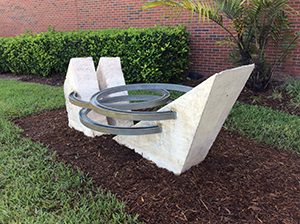
When traveling back and forth across campus on a regular basis, it is easy to become familiar with your surroundings. However, UCF is home to some intriguing artworks that have an interesting story on how they came to campus in the first place. To answer these questions, we asked UCF’s School of Visual Arts and Design (SVAD) faculty member, Kevin Haran, and administrator of the UCF Art in State public art program to share some insight about this program.
How is art that is used on campus obtained?
Kevin Haran: There are two sources. The first of which is private donations. In these cases, the donor is looking for a home for their collection, and UCF is approached. The other source is state funding through the Art in State Buildings program that has placed over 100 works around UCF (the first of which dates back to1987). The big difference between the two types is that the privately donated pieces of art are reviewed by the UCF Foundation in consultation with the School of Visual Arts and Design the College of Art and Humanities Dean’s Office. The state-funded artwork is acquired through a selection process through a committee that is formed.
What is the total number of art pieces that we have on campus?
KH: There are about 115 Art in State objects on campus. These range from a variety of forms such as painting, sculpture, ceramic, to some that are outdoor pieces. The privately donated works are in the hundreds, most of which are kept in the vault at the UCF Art Gallery, however, some are displayed around campus outside. Currently, there is a project underway for the Dr. Phillips Academic Commons at UCF Downtown as well.
How long is the art expected to stay on campus? Is the artwork given to the school?
KH: The artwork that is privately donated is typically gifted. The Art in State artwork is permanent as well, but is technically state property, despite being placed on campus. The committee works with the artist to select the scale, location, and material of the piece. There is a lot of thought in terms of placement as well, as they must consider if the artwork can be touched or even bumped into. Some artwork is placed up high for this reason, so it may not be in harm’s way. As for outdoor objects, the elements and weather definitely can take a toll on the artwork. The work tends to be made of durable materials, however, sometimes things can be damaged over time. The general consensus is that 20 years is an expected lifespan for these pieces, but most should last a lot longer.
The Art in State work is intended to be permanent, but within reason. For example, there are guidelines that provide options for when buildings are renovated, the artwork may no longer be appropriate in that particular space.
What are some of the most notable pieces of art on campus?
KH: There are a number of them, but certainly the work, Sun Target #1, by John Henry near Colbourn Hall. He is an internationally known sculptor. People visit UCF just to see it. There is a print in the Engineering II building by the renowned artist Robert Mapplethorpe as well. Six of Jerry Uelsmann’s pieces are displayed at the Burnett Honors College. Even right in the SVAD administration office, there is a John Chamberlain print, another internationally known sculptor. There are a lot of gems on campus, and the place is so huge, you have to actually seek them out. We are making that easier by incorporating an application within the UCF mobile app so that people can better locate the art. So next time you’re going from class to class, stop and take a look around you, there is most likely a public artwork nearby.
Johann Eyfells Sculpture:
An outdoor sculpture from the early years of the UCF Art Department has just been installed near the Visual Arts Building. The cast concrete and aluminum work from the 1970’s is believed to be a collaborative piece by UCF Professor Johann Eyfells and his students. The sculpture was near the former Colbourn Hall building (the home of the Art Department) and required relocation before the building was demolished. With the support of the SVAD Faculty and approval of the University Master Planning Committee, the art was moved to the grounds of the Visual Arts Building.
If any Art alumni can share a story about this artwork, please contact Kevin Haran, Associate Professor, kevin.haran@ucf.edu.
Information about artist Johann Eyfells can be found at johanneyfells.com
How to access the Public Art map on UCF Mobile: